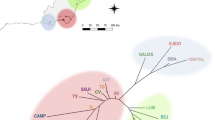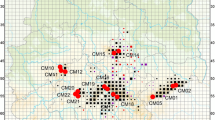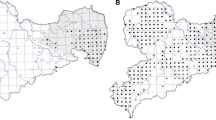Abstract
Including population genetic aspects into the selection of planting material within the framework of conservation and restoration measures is of vital importance for the long-term persistence of populations. This is especially true facing climate change since genetic diversity and the spread of potentially beneficial alleles are important for the adaptability of populations. Therefore, knowledge about genetic variability within and between populations is a critical aspect when determining provenance regions. In our study, we investigated the population genetic structure of a widespread, insect-pollinated and mainly bird-dispersed shrub species, Frangula alnus, on the basis of seven microsatellites and two chloroplast DNA markers throughout Germany. The aim was to determine the spatial, temporal and ecological processes genetically structuring populations to critically revise existing provenance regions. Therefore, we conducted analyses on different spatial scales (country-wide, regional and local) using the two different marker sets in addition to environmental variables. We detected distinct patterns on all spatial scales which indicated influences of historic recolonization processes, regional differences of seed dispersal across the landscape, as well as small-scale spatial genetic structures attributable to local dispersal processes. No relation of underlying environmental gradients such as temperature or precipitation and genetic patterns was found. We conclude that different aspects of historic and more recent gene flow shape population genetic structures and that a thorough analysis on a variety of spatial, temporal and environmental scales is necessary to appropriately select planting material for conservation and restoration measures. Correspondingly, management advice regarding provenance delineations will be provided.







Similar content being viewed by others
References
Alberto F (2009) MsatAllele_1.0: an R package to visualize the binning of microsatellite alleles. J Hered 100(3):394–397. doi:10.1093/jhered/esn110
Ashley MV, Abraham ST, Backs JR, Koenig WD (2015) Landscape genetics and population structure in valley oak (Quercus lobata Nee). Am J Bot 102(12):2124–2131. doi:10.3732/ajb.1500182
Austerlitz F, Mariette S, Machon N, Gouyon P, Godelle B (2000) Effects of colonization processes on genetic diversity: difference between annual plants and tree species. Genetics 154:1309–1321
Azpilicueta MM, Gallo LA, van Zonneveld M, Thomas E, Moreno C, Marchelli P (2013) Management of Nothofagus genetic resources: definition of genetic zones based on a combination of nuclear and chloroplast marker data. Forest Ecol Manag 302:414–424. doi:10.1002/ece3.1108
Bandelt HJ, Forster P, Sykes BC, Richards MB (1995) Mitochondrial portraits of human populations using median networks. Genetics 141(2):743–753
Barsch F, Heym A, Nehring S (2012) Leitfaden zur Verwendung gebietseigener Gehölze. https://www.bfn.de/fileadmin/BfN/recht/Dokumente/leitfaden_gehoelze_.pdf. Accessed 25 July 2015
Beatty GE, Montgomery WI, Tosh DG, Provan J (2015) Genetic provenance and best practice woodland management: a case study in native alder (Alnus glutinosa). Tree Genet Genomes 11(5):92. doi:10.1007/s11295-015-0919-1
Booy G, Hendriks RJJ, Smulders MJM, Groenendael JM, Vosman B (2000) Genetic diversity and the survival of populations. Plant Biol 2(4):379–395. doi:10.1055/s-2000-5958
Borcard D, Gillet F, Legendre P (2011) Numerical ecology with R. Springer, New York
Bower AD, St. Clair JB, Erickson V (2014) Generalized provisional seed zones for native plants. Ecol Appl 24(5):913–919. doi:10.1890/13-0285.1
Bucci G, Gonzalez-Martinez SC, Le Provost G, Plomion C, Ribeiro MM, Sebastiani F, Alia R, Vendramin GG (2007) Range-wide phylogeography and gene zones in Pinus pinaster Ait. revealed by chloroplast microsatellite markers. Mol Ecol 16(10):2137–2153. doi:10.1111/j.1365-294X.2007.03275.x
Burban, Petit, Carcreff, Jactel (1999) Rangewide variation of the maritime pine bast scale Matsucoccus feytaudi Duc. (Homoptera: Matsucoccidae) in relation to the genetic structure of its host. Mol Ecol 8(10):1593–1602. doi:10.1046/j.1365-294x.1999.00739.x
Cornille A, Giraud T, Bellard C, Tellier A, Le Cam B, Smulders MJM, Kleinschmit J, Roldan-Ruiz I, Gladieux P (2013) Postglacial recolonization history of the European crabapple (Malus sylvestris Mill.), a wild contributor to the domesticated apple. Mol Ecol 22(8):2249–2263. doi:10.1111/mec.12231
Daneck H, Fér T, Marhold Fls K (2016) Glacial survival in northern refugia?: Phylogeography of the temperate shrub Rosa pendulina L. (Rosaceae): AFLP vs. chloroplast DNA variation. Biol J Linn Soc 119(3):704–718. doi:10.1111/bij.12619
De Kort H, Mergeay J, Vander Mijnsbrugge K, Decocq G, Maccherini S, Kehlet Bruun HH, Honnay O, Vandepitte K, Bugmann H (2014) An evaluation of seed zone delineation using phenotypic and population genomic data on black alder Alnus glutinosa. J Appl Ecol 51(5):1218–1227. doi:10.1111/1365-2664.12305
De Kort H, Vandepitte K, Mergeay J, Mijnsbrugge KV, Honnay O (2015) The population genomic signature of environmental selection in the widespread insect-pollinated tree species Frangula alnus at different geographical scales. Heredity 115(5):415–425. doi:10.1038/hdy.2015.41
Eimert K, Reutter G, Strolka B (2003) Fast and reliable detection of doubled-haploids in Asparagus officinalis by stringent RAPD-PCR. J Agr Sci 141(1):73–78. doi:10.1017/S0021859603003447
Ellstrand NC (2014) Is gene flow the most important evolutionary force in plants? Am J Bot 101(5):737–753. doi:10.3732/ajb.1400024
Evanno G, Regnaut S, Goudet J (2005) Detecting the number of clusters of individuals using the software STRUCTURE: a simulation study. Mol Ecol 14(8):2611–2620. doi:10.1111/j.1365-294X.2005.02553.x
GeoBasis-DE/BKG (2015) Digitales geländemodell gitterweite 200m. Bundesamt für Kartographie und Geodäsie. Dataset: http://www.geodatenzentrum.de/geodaten/gdz_rahmen.gdz_div?gdz_spr=deu&gdz_akt_zeile=5&gdz_anz_zeile=1&gdz_unt_zeile=3&gdz_user_id=0
Gerlach G, Jueterbock A, Kraemer P, Deppermann J, Harmand P (2010) Calculations of population differentiation based on GST and D—forget GST but not all of statistics! Mol Ecol 19(18):3845–3852. doi:10.1111/j.1365-294X.2010.04784.x
Goudet J (1995) FSTAT (Version 1.2): a computer program to calculate F-statistics. J Hered 86:485–486. doi:10.1093/oxfordjournals.jhered.a111627
Hampe A (2004) Extensive hydrochory uncouples spatiotemporal patterns of seedfall and seedling recruitment in a ‘bird-dispersed’ riparian tree. J Ecol 92(5):797–807. doi:10.1111/j.0022-0477.2004.00918.x
Hampe A, Petit RJ (2005) Conserving biodiversity under climate change: the rear edge matters. Ecol Lett 8(5):461–467. doi:10.1111/j.1461-0248.2005.00739.x
Hampe A, Arroyo J, Jordano P, Petit RJ (2003) Rangewide phylogeography of a bird-dispersed Eurasian shrub: contrasting Mediterranean and temperate glacial refugia. Mol Ecol 12(12):3415–3426. doi:10.1046/j.1365-294X.2003.02006.x
Hamrick JL, Godt MJW (1996) Effects of life history traits on genetic diversity in plant species. Philos T Roy Soc B 351(1345):1291–1298. doi:10.1098/rstb.1996.0112
Hardy OJ, Vekemans X (1999) Isolation by distance in a continuous population: reconciliation between spatial autocorrelation analysis and population genetics models. Heredity 83(2):145
Hardy OJ, Vekemans X (2002) Spagedi—a versatile computer program to analyse spatial genetic structure at the individual or population levels. Mol Ecol Notes 2(4):618–620. doi:10.1046/j.1471-8286.2002.00305.x
Havrdová A, Douda J, Krak K, Vít P, Hadincová V, Zákravský P, Mandák B (2015) Higher genetic diversity in recolonized areas than in refugia of Alnus glutinosa triggered by continent-wide lineage admixture. Mol Ecol 24(18):4759–4777. doi:10.1111/mec.13348
Heuertz M, Fineschi S, Anzidei M, Pastorelli R, Salvini D, Paule L, Frascaria-Lacoste N, Hardy OJ, Vekemans X, Vendramin GG (2004) Chloroplast DNA variation and postglacial recolonization of common ash (Fraxinus excelsior L.) in Europe. Mol Ecol 13(11):3437–3452. doi:10.1111/j.1365-294X.2004.02333.x
Hufford KM, Krauss SL, Veneklaas EJ (2012) Inbreeding and outbreeding depression in Stylidium hispidum: implications for mixing seed sources for ecological restoration. Ecol Evol 2(9):2262–2273. doi:10.1002/ece3.302
Jakobsson M, Rosenberg NA (2007) CLUMPP: a cluster matching and permutation program for dealing with label switching and multimodality in analysis of population structure. Bioninformatics 23(14):1801–1806. doi:10.1093/bioinformatics/btm233
Jost L (2008) GST and its relatives do not measure differentiation. Mol Ecol 17(18):4015–4026. doi:10.1111/j.1365-294X.2008.03887.x
Kremer A, Ronce O, Robledo-Arnuncio JJ, Guillaume F, Bohrer G, Nathan R, Bridle JR, Gomulkiewicz R, Klein EK, Ritland K, Kuparinen A, Gerber S, Schueler S (2012) Long-distance gene flow and adaptation of forest trees to rapid climate change. Ecol Lett 15(4):378–392. doi:10.1111/j.1461-0248.2012.01746.x
Lavabre JE, Gilarranz LJ, Fortuna MA, Bascompte J (2016) How does the functional diversity of frugivorous birds shape the spatial pattern of seed dispersal?: a case study in a relict plant species. Phil Trans R Soc B 371(1694):20150280. doi:10.1098/rstb.2015.0280
Legendre P, Gallagher E (2001) Ecologically meaningful transformations for ordination of species data. Oecologia 129(2):271–280. doi:10.1007/s004420100716
López-Vinyallonga S, López-Pujol J, Constantinidis T, Susanna A, Garcia-Jacas N (2015) Mountains and refuges: genetic structure and evolutionary history in closely related, endemic Centaurea in continental Greece. Mol Phylogenet Evol 92:243–254. doi:10.1038/srep37818
Malaval S, Lauga B, Regnault-Roger C, Largier G (2010) Combined definition of seed transfer guidelines for ecological restoration in the French Pyrenees. Appl Veg Sci 13(1):113–124. doi:10.1111/j.1654-109X.2009.01055.x
McKay JK, Christian CE, Harrison S, Rice KJ (2005) “How local is local?”—a review of practical and conceptual issues in the genetics of restoration. Restor Ecol 13(3):432–440. doi:10.1111/j.1526-100X.2005.00058.x
Michalski SG, Durka W (2012) Assessment of provenance delineation by genetic differentiation patterns and estimates of gene flow in the common grassland plant Geranium pratense. Conserv Genet 13(2):581–592. doi:10.1111/1365-2664.12636
Mijangos JL, Pacioni C, Spencer PBS, Craig MD (2015) Contribution of genetics to ecological restoration. Mol Ecol 24(1):22–37. doi:10.1111/mec.12995
Miller SA, Bartow A, Gisler M, Ward K, Young AS, Kaye TN (2011) Can an ecoregion serve as a seed transfer zone? Evidence from a common garden study with five native species. Restor Ecol 19(201):268–276. doi:10.1111/j.1526-100X.2010.00702.x
Nathan R, Schurr FM, Spiegel O, Steinitz O, Trakhtenbrot A, Tsoar A (2008) Mechanisms of long-distance seed dispersal. Trends Ecol Evol 23(11):638–647. doi:10.1016/j.tree.2008.08.003
Oksanen JF, Blanchet G, Kindt R, Legendre P, Minchin PR, O’Hara RB, Simpson GL, Solymos P, Stevens MHH, Wagner H (2015) vegan: Community Ecology Package. R package version 2.3–1. http://CRAN.R-project.org/package=vegan. Accessed 12 November 2015
van Oosterhout C, Hutchinson WF, Wills DP, Shipley P (2004) Micro-checker: software for identifying and correcting genotyping errors in microsatellite data. Mol Ecol Notes 4(3):535–538. doi:10.1111/j.1471-8286.2004.00684.x
Pautasso M (2009) Geographical genetics and the conservation of forest trees. Perspect Plant Ecol Evol Syst 11(3):157–189. doi:10.1016/j.ppees.2009.01.003
Peakall RO, Smouse PE (2006) GenAlEx 6: genetic analysis in Excel. Population genetic software for teaching and research. Mol Ecol Notes 6(1):288–295. doi:10.1093/bioinformatics/bts460
Petit RJ, El Mousadik A, Pons O (1998) Identifying populations for conservation on the basis of genetic markers. Conserv Biol 12(4):844–855. doi:10.1111/j.1523-1739.1998.96489.x
Petit R, Aguinagalde I, de Beaulieu JL, Bittkau C, Brewer S, Cheddadi R, Ennos R, Fineschi S, Grivet D, Lascoux M, Mohanty A, Müller-Starck G, Demesure-Musch B, Palmé A, Martín JP, Rendell S, Vendramin GG (2003) Glacial refugia: hotspots but not melting pots of genetic diversity. Science 300(5625):1563–1565. doi:10.1126/science.1083264
Pluess AR, Frank A, Heiri C, Lalagüe H, Vendramin GG, Oddou-Muratorio S (2016) Genome-environment association study suggests local adaptation to climate at the regional scale in Fagus sylvatica. New Phytol 210(2):589–601. doi:10.1111/nph.13809
Pons O, Petit RJ (1996) Measuring and testing genetic differentiation with ordered versus unordered alleles. Genetics 144(3):1237–1245
Potter KM, Hargrove WW (2012) Determining suitable locations for seed transfer under climate change—a global quantitative method. New Forest 43(5–6):581–599. doi:10.1007/s11056-012-9322-z
Pritchard JK, Stephens M, Donelly P (2000) Inference of population structure using multilocus genotype data. Genetics 155:945–959
R Development Core Team (2014) R: a language and environment for statistical computing. R Foundation for Statistical Computing, Vienna. URL http://www.R-project.org
Reiker J, Schulz B, Wissemann V, Gemeinholzer B (2015) Does origin always matter? Evaluating the influence of nonlocal seed provenances for ecological restoration purposes in a widespread and outcrossing plant species. Ecol Evol 5(23):5642–5651. doi:10.1002/ece3.1817
Rigueiro C, Arroyo JM, Rodríguez R, Hampe A, Jordano P (2009) Isolation and characterization of 16 polymorphic microsatellite loci for Frangula alnus (Rhamnaceae). Mol Ecol Notes 9(3):986–989. doi:10.1111/j.1755-0998.2009.02527.x
Rousset F (2008) genepop’007: a complete re-implementation of the genepop software for Windows and Linux. Mol Ecol Notes 8(1):103–106. doi:10.1111/j.1471-8286.2007.01931.x
Taberlet P, Fumagalli L, Wust-Saucy A-G, Cosson J-F (1998) Comparative phylogeography and postglacial colonization routes in Europe. Mol Ecol 7(4):453–464
Vega Rivera JH, McShea WJ, Rappole JH, Haas CA (1999) Postbreeding movements and habitat use of adult wood thrushes in Northern Virginia. Auk 116(2):458–466. doi:10.2307/4089379
Ying CC, Yanchuk AD (2006) The development of British Columbia’s tree seed transfer guidelines: purpose, concept, methodology, and implementation. Forest Ecol Manag 227(1–2):1–13. doi:10.1016/j.foreco.2006.02.028
Zavodna M, Abdelkrim J, Pellissier V, Machon N (2015) A long-term genetic study reveals complex population dynamics of multiple-source plant reintroductions. Biol Conserv 192:1–9. doi:10.1016/j.biocon.2015.08.025
Zecchin B, Caudullo G, Rigo DD (2016) Frangula alnus in Europe: distribution, habitat, usage and threats. In: San-Miguel-Ayanz J, de Rigo D, Caudullo G, Houston Durrant T, Mauri A (eds) European Atlas of Forest Tree Species. Publication Ofice EU, Luxembourg, p e019ee2+ https://w3id.org/mtv/FISE-Comm/v01/e019ee2. Accessed 25.01.2017
Acknowledgements
We are very grateful to all the forest rangers, colleagues and friends who supported this study by collecting leaf material for the genetic analysis throughout Germany. Many thanks go to Christina Mengel and Sascha Liepelt for their support and helpful advices regarding the laboratory work. Moreover, we would like to thank two anonymous reviewers for their helpful comments. This project was funded by the program “Forschung für die Praxis” by the Hesse State Ministry of Higher Education, Research and the Arts.
Author information
Authors and Affiliations
Corresponding author
Ethics declarations
Conflict of interest
The authors declare that they have no competing interests.
Data archiving statement
Genotyping data of all collected samples for the seven microsatellites as well as cpDNA data of the corresponding number of samples are available from the Dryad Digital Repository: http://dx.doi.org/10.5061/dryad.215sn.
Additional information
Communicated by J. Beaulieu
Electronic supplementary material
ESM 1
(DOCX 808 kb)
Rights and permissions
About this article
Cite this article
Mosner, E., Eimert, K., Hüwe, U. et al. Revisiting the provenance delineation of a widespread shrub, Frangula alnus—the role of spatial, temporal and environmental patterns. Tree Genetics & Genomes 13, 63 (2017). https://doi.org/10.1007/s11295-017-1142-z
Received:
Revised:
Accepted:
Published:
DOI: https://doi.org/10.1007/s11295-017-1142-z




